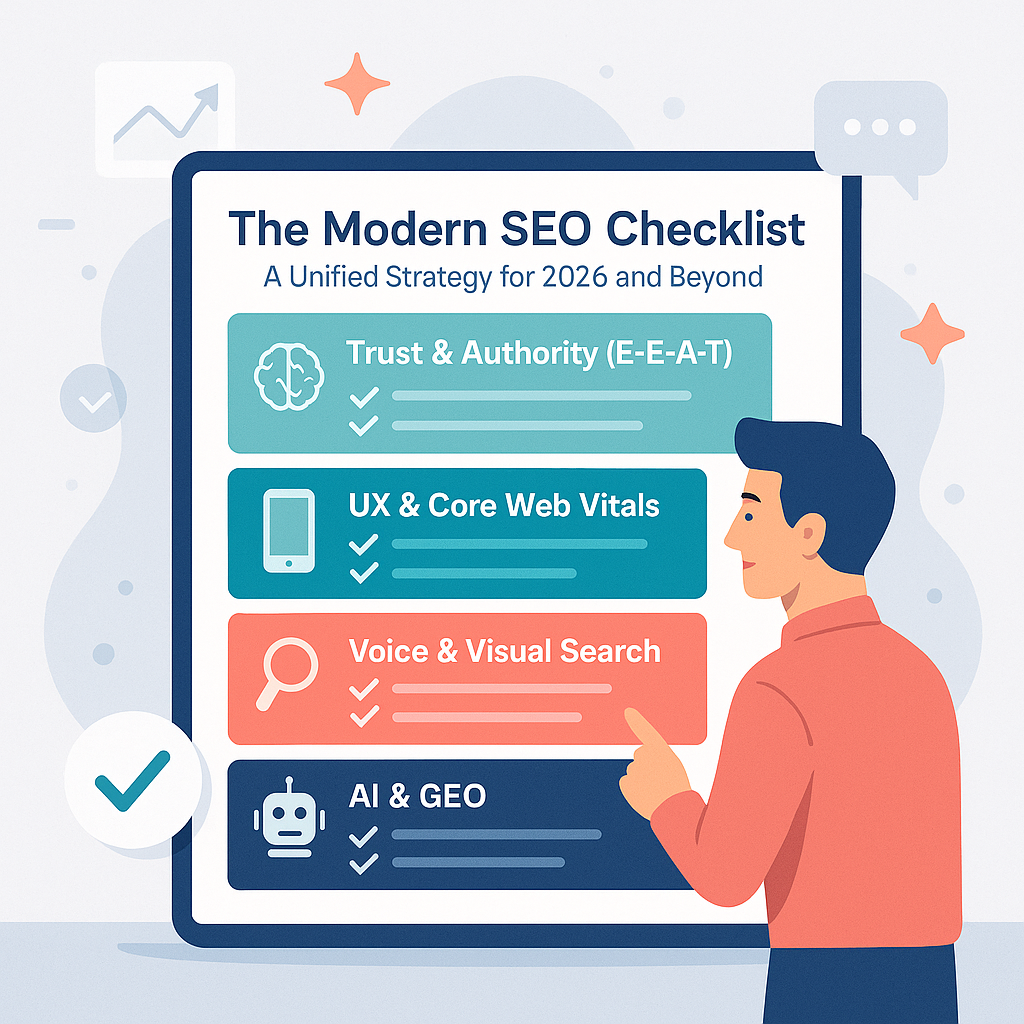For twenty years, the goal of SEO has been to get to the top of the list. What happens when there is no list? Welcome to the era of Generative Engine Optimization (GEO), where search engines don't just give you links—they give you a single, definitive answer. This fundamental shift marks the most significant evolution in search since the advent of Google itself. The familiar page of ten blue links is being replaced by a synthesized, AI-generated response that pulls information from multiple sources to answer a user's query directly.
Traditional SEO strategies are built for a world of ranked lists and keyword competition. But AI-driven platforms like ChatGPT, Perplexity, and Google's AI Overviews are changing the game entirely. These
answer engines synthesize information from multiple sources into one comprehensive response. If your content isn’t structured for this new reality, it will be invisible. This article will serve as your introduction to the new rules of search. We will define GEO, contrast it with the SEO you know, and provide the core strategies you need to ensure your brand's voice is included in the answers of tomorrow.
From Search Engine to Answer Engine: Defining GEO
So, what exactly is Generative Engine Optimization? Let's establish a clear definition.
Generative Engine Optimization (GEO) is the process of optimizing your website’s content to boost its visibility and influence within AI-driven answer engines like ChatGPT, Perplexity, and Google AI Overviews. [2]
This is fundamentally different from traditional SEO. While the two are related, their goals and methods diverge significantly. SEO is a race to the top of a list; GEO is a campaign to become the answer itself. This paradigm shift is perfectly captured by Adam Binder in a recent Forbes article: "While SEO has long been about getting your website to the top of search results, GEO is about ensuring your content is the answer GEs choose to generate." [3]
To fully grasp the change, it helps to see the two disciplines side-by-side.
Feature | Traditional SEO | Generative Engine Optimization (GEO) |
Goal | Rank high on a list of links. | Become a cited source in a single, generated answer. |
Output | A ranked list of sources (the "ten blue links"). | A synthesized, multimodal summary. |
Emphasis | Keywords and backlinks. | Context, structure, and clarity. |
Content | Primarily text-based pages and articles. | Adaptable, multimodal content (text, images, video, audio). |
This table makes the distinction clear. The old model of keyword density and link volume is giving way to a new model that prioritizes clarity, authority, and a rich, multi-format user experience. The future isn't about collecting clicks; it's about contributing to conversations.
The GEO Playbook: How to Optimize for the AI-Powered Future
Understanding the shift from SEO to GEO is one thing; optimizing for it is another. While the new landscape may seem daunting, the core principles of GEO are rooted in the best practices of high-quality content creation and technical SEO. This playbook breaks down the four core strategies you need to master to ensure your brand becomes a trusted source for the answer engines of tomorrow.
1. Speak the Language of AI (Conversational Content)
Generative engines are built on Natural Language Processing (NLP). They are designed to understand and respond to queries in the same way a human would. To optimize for this, your content needs to become more conversational. The era of targeting short, fragmented keywords is evolving. Instead, focus on the questions your audience is actually asking.
Actionable Strategy: Shift your keyword research towards long-tail, question-based queries. Instead of targeting a broad term like "best running shoes," create a comprehensive piece of content that answers the question, "What are the best running shoes for a beginner with flat feet?" This approach not only aligns with how users interact with AI assistants but also captures high-intent traffic looking for specific solutions. By framing your content as the answer to a question, you make it easier for a generative engine to recognize its value and incorporate it into a response. This is a core tenet of modern search engine optimization.
2. Think Beyond Text (Multimodal Content)
AI-generated answers are rarely just a block of text. They are rich, multimodal experiences that can include images, videos, charts, and even interactive elements. To compete in this new environment, your content strategy must be equally diverse. A text-only approach is no longer sufficient.
Actionable Strategy: Diversify your content assets. Supplement your articles with high-quality, well-labeled images, create insightful infographics that simplify complex topics, produce short-form videos that demonstrate your products or explain a service, and consider adding audio versions of your key articles. Each content format provides another signal to the generative engine, giving it more resources to pull from when constructing an answer. This holistic approach to content marketing is essential for GEO.
3. Prioritize Relevance Over Volume (Authoritative Content)
In the race for visibility, GEs act as discerning curators. They are not looking for the most keyword-stuffed page; they are looking for the most reliable, comprehensive, and authoritative answer. This is where the principles of E-E-A-T (Experience, Expertise, Authoritativeness, and Trustworthiness) become more critical than ever. A shallow, 500-word blog post is unlikely to be chosen as a primary source.
Actionable Strategy: Focus your efforts on creating in-depth, authoritative content that fully and completely addresses a user's query. Go beyond surface-level explanations and provide real-world examples, expert insights, and clear, well-structured information. Use clear subheadings, bullet points, and tables to make your content easy for both humans and AI to scan and understand. Investing in high-quality, long-form content is a direct investment in your brand's authority and its future visibility in generative search.
4. Get Technical (Structured Content)
While content is king, technical optimization is the foundation of the castle. Technical SEO provides the clear signals that answer engines need to understand what your content is about and how it relates to other information on the web. A technically sound website is non-negotiable for GEO.
Actionable Strategy: Make structured data (schema markup) a priority. By implementing schema for products, articles, events, and FAQs, you are explicitly defining the entities on your site, making it easier for AI to interpret and categorize your information. Beyond schema, ensure you are using descriptive alt text for all of your images, optimizing your site for speed and mobile-friendliness, and creating a logical internal linking structure. These technical elements of web development are the essential signposts that guide generative engines to your content.
Building for Today and Tomorrow: Unifying Your SEO and GEO Efforts
The emergence of GEO does not mean that your existing SEO efforts are obsolete. In fact, the opposite is true. A strong SEO foundation is the launching pad for a successful GEO strategy. Think of GEO not as a replacement for SEO, but as an evolution of it. The two disciplines should be integrated into a unified strategy that prepares your brand for both the present and the future of search.
As Search Engine Land notes, "While GEO can be considered a digital marketing strategy with its own set of processes, it should be integrated with SEO as the baseline methodology for effectively increasing online visibility." [2] Here’s how to build a holistic strategy that bridges the gap between SEO and GEO:
Unified Content Strategy: The core of a unified strategy is a commitment to creating high-quality, E-E-A-T aligned content. The in-depth, authoritative content that performs well in traditional search is the same content that generative engines will look to for reliable information. Your goal should be to create content that serves both humans and AI, answering user questions comprehensively and authoritatively.
Holistic Keyword Research: Your keyword research process needs to expand. Continue to target traditional keywords that drive traffic and conversions, but augment this research with a focus on long-tail questions and conversational phrases. Use tools that help you understand the questions your audience is asking and build your content around providing the best possible answers.
Technical Excellence: A technically sound website is essential for both SEO and GEO. A fast, mobile-friendly site with a logical structure and clean code will perform better in both traditional search rankings and in the eyes of generative engines. The structured data that is so critical for GEO also powers the rich snippets that help you stand out in traditional search results. Investing in technical SEO is an investment in your visibility across the entire search landscape.
The Future of Search is an Answer
The era of the ten blue links is coming to a close. The future of search is not a list of options; it is a single, synthesized, and multimodal answer. Generative Engine Optimization is the new discipline dedicated to ensuring your brand is a trusted source for that answer. This new frontier requires a shift in mindset, moving from a focus on ranking to a focus on contributing. It requires a commitment to creating conversational, multimodal, authoritative, and technically structured content.
This does not mean you should abandon your SEO efforts. Instead, you should augment them with the principles of GEO. The fundamentals of creating high-quality, user-focused content are more important than ever. By building a unified strategy that embraces both SEO and GEO, you can position your brand for success today and prepare it for the answer engine revolution of tomorrow.
References
[1] HubSpot - Generative engine optimization: What we know so far: https://blog.hubspot.com/marketing/generative-engine-optimization
[2] Search Engine Land - What is generative engine optimization (GEO)?: https://searchengineland.com/what-is-generative-engine-optimization-geo-444418
[3] Forbes - Generative Engine Optimization (GEO): The Future Of Search Is Here: https://www.forbes.com/councils/forbesagencycouncil/2025/01/02/generative-engine-optimization-geo-the-future-of-search-is-here/

